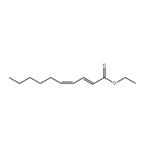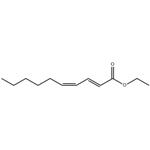Ethyl-trans-2, cis-4-decadienoate has a characteristic pear-like flavor and a light fruity aroma.
Ethyl (2E,4Z)-2,4-Decadienoate (Ethyl 2-trans-4-cis-decadienoate) has been identified in pears and has the typical aroma of Williams pears. Synthesis of ethyl (2E,4Z)-2,4-decadienoate starts from (Z)-1-heptenyl bromide, which is converted into a 1-heptenyllithium cuprate complex with lithium and copper iodide. Reaction with ethyl propiolate yields a mixture of 95% ethyl (2E,4Z)- and 5% ethyl (2E,4E)-2,4-decadienoate. Pure ethyl (2E,4Z)-2,4-decadienoate is obtained by fractional distillation. A biotechnological process for its preparation has been developed.
clear colorless to yellowish liquid
Reported found in Bartlett pears, apple, grape, durian (Durio zibethinus), pear brandy, quince and spineless
monkey orange (Strychnos madagasc).
The potential applications of Ethyl 2-trans-4-cis-decadienoate include the profile enhancement of guava, melon, pear, apple, banana, kiwi, grape, golden delicious apple, fruit cocktail juices, fruit nectar, mamey and other tropical backgrounds.
Ethyl 2-trans-4-cis-decadienoate (DDSE) is a flavoring that is largely responsible for the aroma of Williams pears is responsible.
Ethyl (2E,4Z)-deca-2,4-dienoate (Ethyl 2-trans-4-cis-decadienoate) is a fatty acid ethyl ester resulting from the formal condensation of the carboxy group of (2E,4E)-deca-2,4-dienoic acid with the hydroxy group of ethanol. It has a role as a plant metabolite, a flavouring agent, a fragrance and a kairomone. It is a natural product found in Euglena gracilis.
Stillingia oil is one of the fruits of the tallow tree native to China (Stillingia sebifera or Sapium sepiferum, Euphorbiaceae) vegetable fat. It contains about 5% of DDS in the form of glycerides by weight. Ethyl 2-trans-4-cis-decadienoate (DDSE) can be obtained from this by base-catalyzed transesterification with ethanol; however, in food law, this is not a natural process, so the product obtained cannot be called a natural flavouring.
A mixture of Stillingia oil (5 kg), natural ethanol (1.0 kg) and Novozym 435 (1.0 kg) was overlaid with nitrogen in a 20-liter glass vessel at 45 ° C and slowly stirred. The vessel was fitted with a water cooler to prevent losses and minimize evaporation. The approach was cancelled after an incubation period of 2 to 3 each Day. The filtered enzyme was added with fresh Stillingia oil and natural ethanol, and stirring was continued. All 10 cycles were performed, the content of Ethyl 2-trans-4-cis-decadienoate from the individual filtrates varied between 4.0 and 4.7% by weight.
Detection: 100 ppb. Aroma characteristics at 1.0%: sweet ripe pear, creamy and slightly fatty with fruity,
green, waxy apple, fleshy nuances
Taste characteristics at 5 ppm: ripe pear, green fruity, waxy apple, tropical notes, fatty golden delicious apple
fleshy. Taste characteristics at 20 ppm: green, fruity, apple and pear with waxy tropical nuances.
Natural occurrence: Apple, pear, grape, pear brandy and quince.
Synthetically via the lithium vinyl cuprates.



